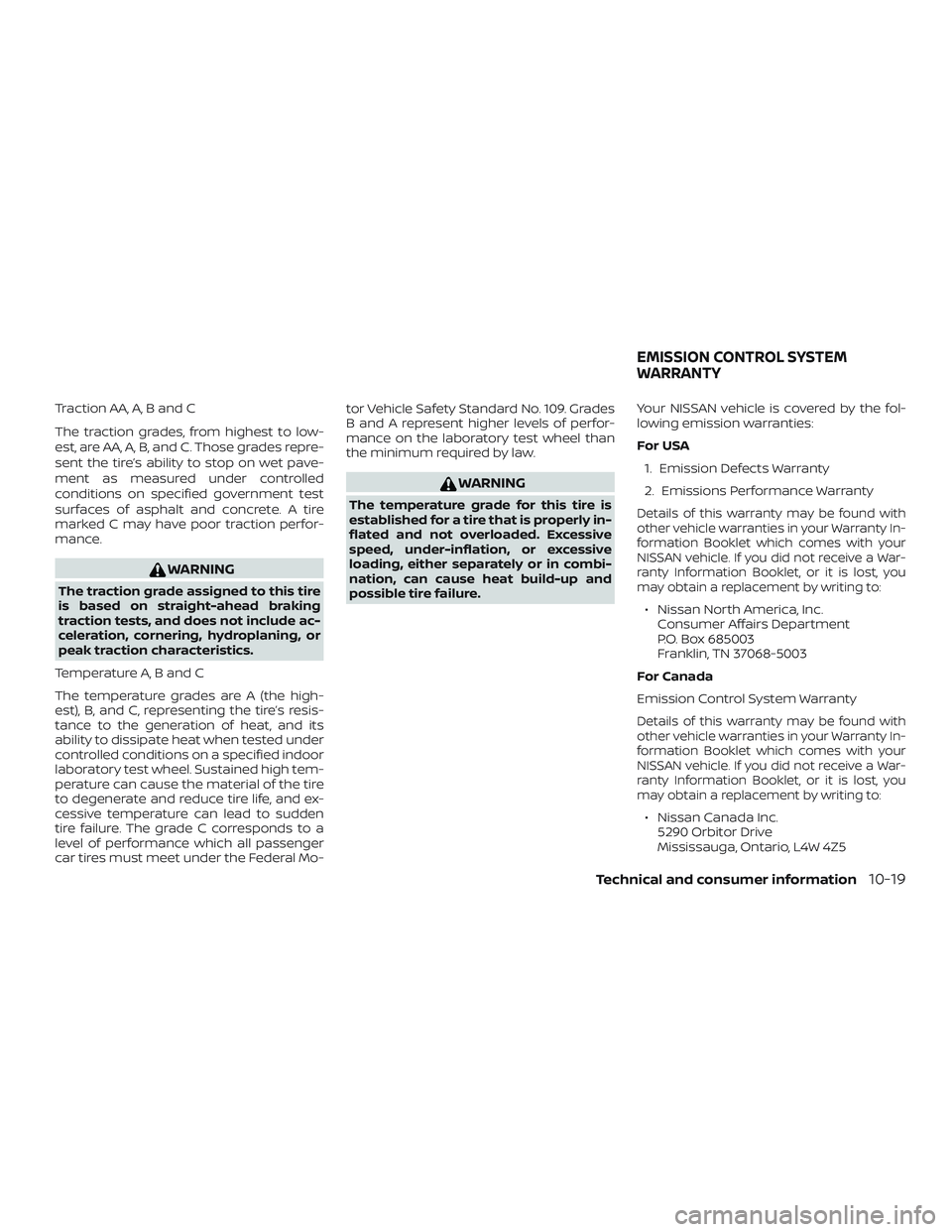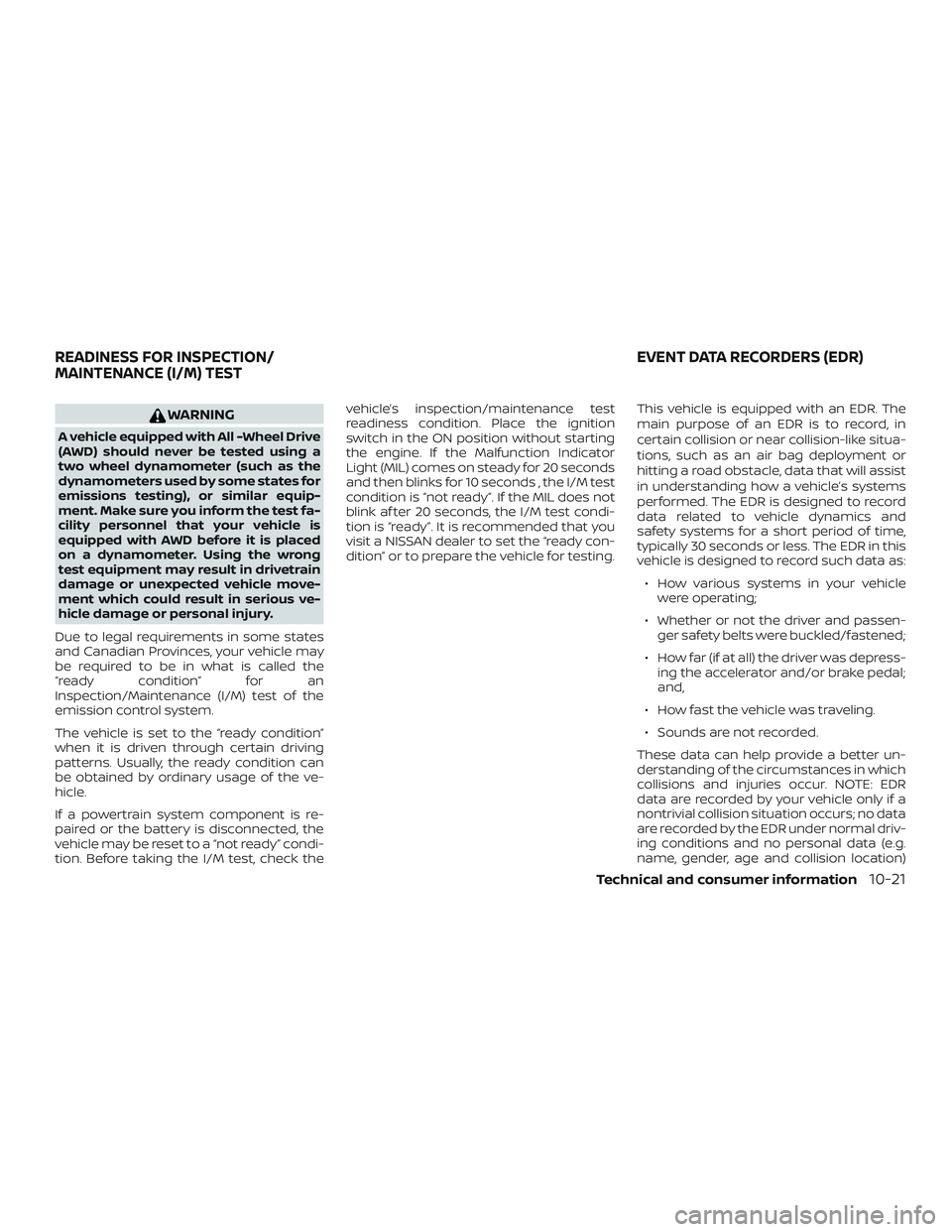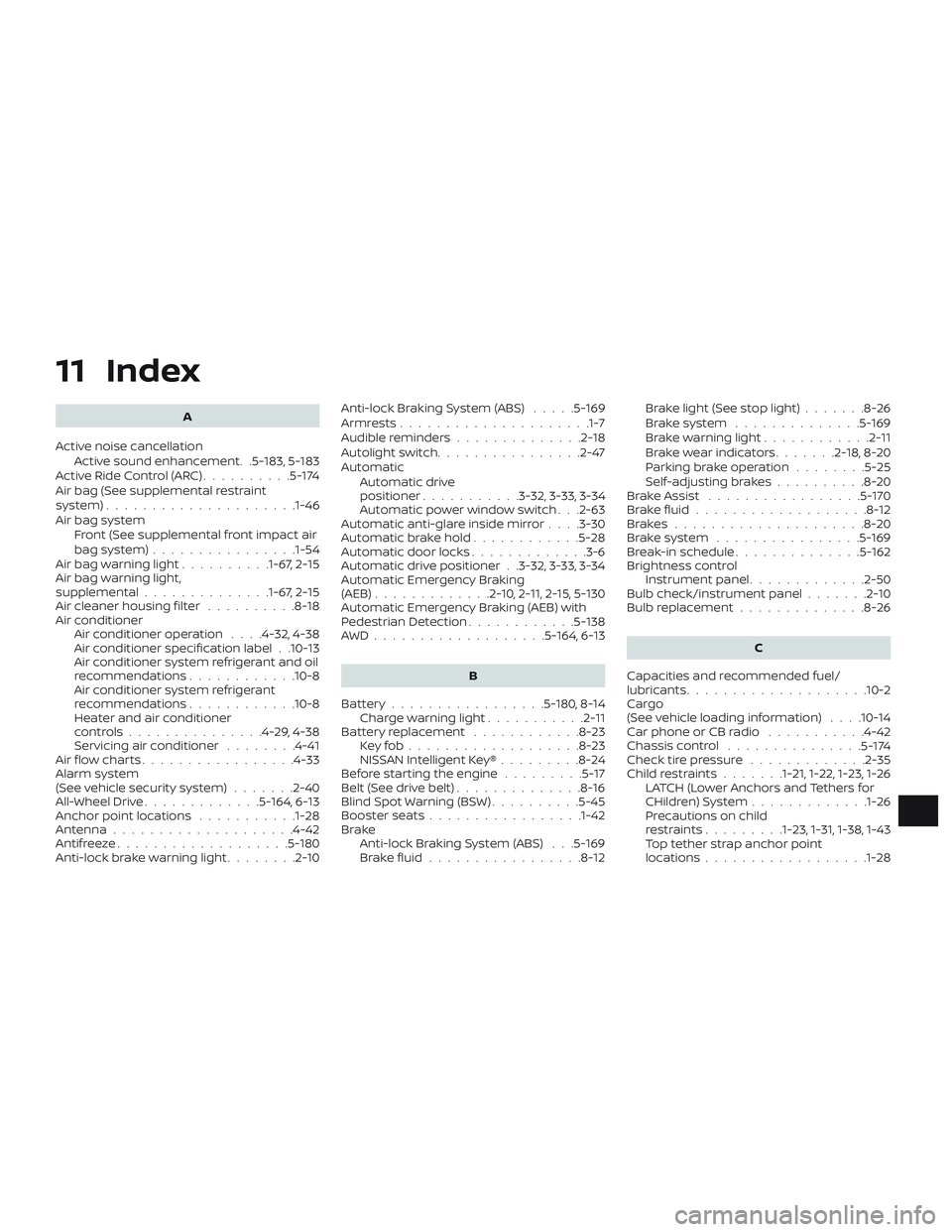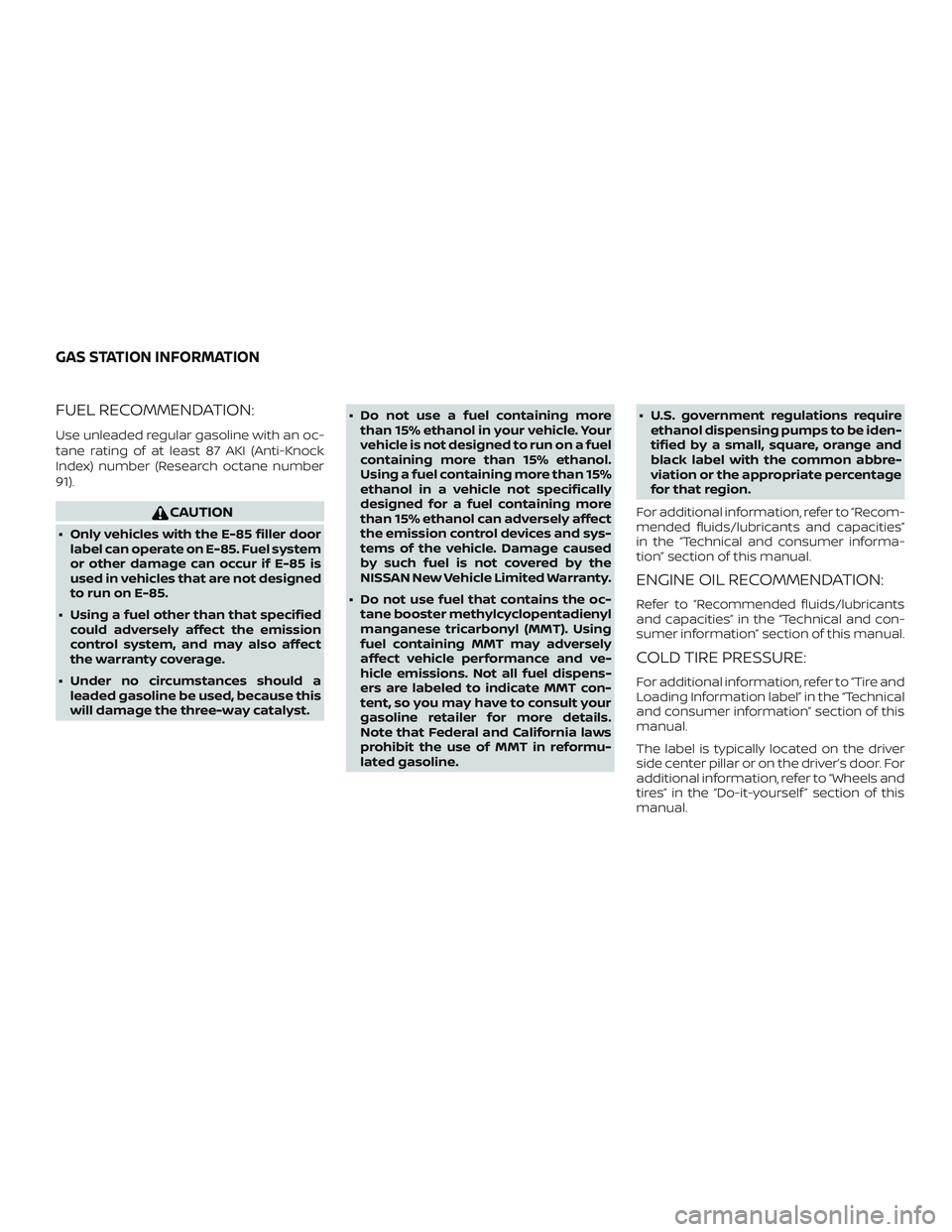2020 NISSAN ALTIMA wheel
[x] Cancel search: wheelPage 540 of 559

Traction AA, A, B and C
The traction grades, from highest to low-
est, are AA, A, B, and C. Those grades repre-
sent the tire’s ability to stop on wet pave-
ment as measured under controlled
conditions on specified government test
surfaces of asphalt and concrete. A tire
marked C may have poor traction perfor-
mance.
WARNING
The traction grade assigned to this tire
is based on straight-ahead braking
traction tests, and does not include ac-
celeration, cornering, hydroplaning, or
peak traction characteristics.
Temperature A, B and C
The temperature grades are A (the high-
est), B, and C, representing the tire’s resis-
tance to the generation of heat, and its
ability to dissipate heat when tested under
controlled conditions on a specified indoor
laboratory test wheel. Sustained high tem-
perature can cause the material of the tire
to degenerate and reduce tire life, and ex-
cessive temperature can lead to sudden
tire failure. The grade C corresponds to a
level of performance which all passenger
car tires must meet under the Federal Mo- tor Vehicle Safety Standard No. 109. Grades
B and A represent higher levels of perfor-
mance on the laboratory test wheel than
the minimum required by law.
WARNING
The temperature grade for this tire is
established for a tire that is properly in-
flated and not overloaded. Excessive
speed, under-inflation, or excessive
loading, either separately or in combi-
nation, can cause heat build-up and
possible tire failure.
Your NISSAN vehicle is covered by the fol-
lowing emission warranties:
For USA
1. Emission Defects Warranty
2. Emissions Performance WarrantyDetails of this warranty may be found with
other vehicle warranties in your Warranty In-
formation Booklet which comes with your
NISSAN vehicle. If you did not receive a War-
ranty Information Booklet, or it is lost, you
may obtain a replacement by writing to:
∙ Nissan North America, Inc. Consumer Affairs Department
P.O. Box 685003
Franklin, TN 37068-5003
For Canada
Emission Control System Warranty
Details of this warranty may be found with
other vehicle warranties in your Warranty In-
formation Booklet which comes with your
NISSAN vehicle. If you did not receive a War-
ranty Information Booklet, or it is lost, you
may obtain a replacement by writing to:
∙ Nissan Canada Inc. 5290 Orbitor Drive
Mississauga, Ontario, L4W 4Z5
EMISSION CONTROL SYSTEM
WARRANTY
Technical and consumer information10-19
Page 542 of 559

WARNING
A vehicle equipped with All -Wheel Drive
(AWD) should never be tested using a
two wheel dynamometer (such as the
dynamometers used by some states for
emissions testing), or similar equip-
ment. Make sure you inform the test fa-
cility personnel that your vehicle is
equipped with AWD before it is placed
on a dynamometer. Using the wrong
test equipment may result in drivetrain
damage or unexpected vehicle move-
ment which could result in serious ve-
hicle damage or personal injury.
Due to legal requirements in some states
and Canadian Provinces, your vehicle may
be required to be in what is called the
“ready condition” for an
Inspection/Maintenance (I/M) test of the
emission control system.
The vehicle is set to the “ready condition”
when it is driven through certain driving
patterns. Usually, the ready condition can
be obtained by ordinary usage of the ve-
hicle.
If a powertrain system component is re-
paired or the battery is disconnected, the
vehicle may be reset to a “not ready” condi-
tion. Before taking the I/M test, check the vehicle’s inspection/maintenance test
readiness condition. Place the ignition
switch in the ON position without starting
the engine. If the Malfunction Indicator
Light (MIL) comes on steady for 20 seconds
and then blinks for 10 seconds , the I/M test
condition is “not ready”. If the MIL does not
blink af ter 20 seconds, the I/M test condi-
tion is “ready”. It is recommended that you
visit a NISSAN dealer to set the “ready con-
dition” or to prepare the vehicle for testing.
This vehicle is equipped with an EDR. The
main purpose of an EDR is to record, in
certain collision or near collision-like situa-
tions, such as an air bag deployment or
hitting a road obstacle, data that will assist
in understanding how a vehicle’s systems
performed. The EDR is designed to record
data related to vehicle dynamics and
safety systems for a short period of time,
typically 30 seconds or less. The EDR in this
vehicle is designed to record such data as:
∙ How various systems in your vehicle were operating;
∙ Whether or not the driver and passen- ger safety belts were buckled/fastened;
∙ How far (if at all) the driver was depress- ing the accelerator and/or brake pedal;
and,
∙ How fast the vehicle was traveling.
∙ Sounds are not recorded.
These data can help provide a better un-
derstanding of the circumstances in which
collisions and injuries occur. NOTE: EDR
data are recorded by your vehicle only if a
nontrivial collision situation occurs; no data
are recorded by the EDR under normal driv-
ing conditions and no personal data (e.g.
name, gender, age and collision location)
READINESS FOR INSPECTION/
MAINTENANCE (I/M) TEST EVENT DATA RECORDERS (EDR)
Technical and consumer information10-21
Page 546 of 559

11 Index
A
Active noise cancellation Active sound enhancement. .5-183, 5-183
ActiveRideControl(ARC)..........5-174
Air bag (See supplemental restraint
system) .................... .1-46
Air bag system Front (See supplemental front impact air
bagsystem)............... .1-54
Airbagwarninglight..........1-67, 2-15
Air bag warning light,
supplemental ..............1-67, 2-15
Air cleaner housing filter ..........8-18
Air conditioner Air conditioner operation ....4-32,4-38
Air conditioner specification label . .10-13
Air conditioner system refrigerant and oil
recommendations ............10-8
Air conditioner system refrigerant
recommendations ............10-8
Heater and air conditioner
controls...............4-29,4-38
Servicing air conditioner ........4-41
Air flow charts .................4-33
Alarm system
(See vehicle security system) .......2-40
All-Wheel Drive .............5-164,6-13
Anchor point locations ...........1-28
Antenna ....................4-42
Antifreeze ...................5-180
Anti-lock brake warning light ........2-10Anti-lock Braking System (ABS)
.....5-169
Armrests.................... .1-7
Audible reminders ..............2-18
Autolightswitch................2-47
Automatic Automatic drive
positioner ...........3-32,3-33,3-34
Automatic power window switch . . .2-63
Automatic anti-glare inside mirror ....3-30
Automaticbrakehold............5-28
Automatic door locks .............3-6
Automatic drive positioner . .3-32, 3-33, 3-34
Automatic Emergency Braking
(AEB) .............2-10,2 -11, 2-15, 5-130
Automatic Emergency Braking (AEB) with
Pedestrian Detection ............5-138
AWD...................5-164,6-13
B
Battery.................5-180,8-14 Charge warning light ...........2-11
Battery replacement ............8-23
Keyfob...................8-23
NISSAN Intelligent Key® .........8-24
Before starting the engine .........5-17
Belt(Seedrivebelt)..............8-16
Blind Spot Warning (BSW) ..........5-45
Booster seats .................1-42
Brake Anti-lock Braking System (ABS) . . .5-169
Brakefluid.................8-12 Brakelight(Seestoplight).......8-26
Brakesystem ..............5-169
Brakewarninglight............2-11
Brakewearindicators.......2-18,8-20
Parking brake operation
........5-25
Self-adjustingbrakes..........8-20
Brake Assist .................5-170
Brakefluid...................8-12
Brakes.....................8-20
Brakesystem ................5-169
Break-in schedule ..............5 -162
Brightness control Instrument panel .............2-50
Bulb check/instrument panel .......2-10
Bulb replacement .............. 8-26
C
Capacities and recommended fuel/
lubricants....................10-2
Cargo
(See vehicle loading information) . . . .10-14
Car phone or CB radio ...........4-42
Chassis control ...............
5-174
Check tire pressure .............2-35
Childrestraints.......1-21, 1-22, 1-23, 1-26 LATCH (Lower Anchors and Tethers for
CHildren)System.............1-26
Precautions on child
restraints.........1-23, 1-31, 1-38, 1-43
Top tether strap anchor point
locations..................1-28
Page 548 of 559

FuelCapacities and recommended
fuel/lubricants...............10-2
Fuel economy ...............5-164
Fuel-filler door and cap ..........3-25
Fuel-filler door lock opener lever ....3-25
Fuel gauge ..................2-7
Fueloctanerating.............10-6
Fuel recommendation ..........10-4
Loose fuel cap warning .........2-35
Fuelefficientdrivingtips ..........5-163
Fuel-filler door .................3-25
Fuel gauge ....................2-7
Fuses .......................8-21
Fusiblelinks...................8-22
G
Garage door opener, HomeLink® Universal
Transceiver . . .2-67, 2-68, 2-69, 2-70, 2-70, 2-71
Gascap.....................3-25
Gauge Engine coolant temperature gauge . .2-6
Fuel gauge ..................2-7
Odometer ..................2-5
Speedometer ..............2-4,2-5
Tachometer .................2-6
Trip odometer .............2-4,2-5
General maintenance .............9-2
Glovebox....................2-59
Gloveboxlock.................2-59 H
Hazard warning flasher switch ........6-2
Headlight and turn signal switch ......2-45
Headlightcontrolswitch...........2-45
Headlights ...................8-25
Headrestraints................. .1-7
Heated seat switches ............2-52
Heated steering wheel ............2-53
Heater Heater and air conditioner
controls................4-29,4-38
Heater operation ..........4-30,4-39
Hill start assist system ............5-174
HomeLink® Universal
Transceiver . . .2-67, 2-68, 2-69, 2-70, 2-70, 2-71
Hood .......................3-22
Horn.......................2-52
I
Ignition switch Push-button ignition switch .......5-13
Immobilizer system ..........2-42,5-16
Important vehicle information label . . .10-12
In-cabinmicrofilter..............8-18
Increasing fuel economy ..........5-164
Indicator NISSAN Intelligent Key® battery discharge
indicator...................5-16
Indicator lights and audible reminders
(See warning/indicator lights and audible
reminders) ....................2-15
Inside automatic anti-glare mirror .....3-30
Instrument brightness control .......2-50Instrument panel
.............0-6,2-2
Instrument panel dimmer switch .....2-50
Intelligent Around View Monitor .......4-11
Intelligent Cruise Control (ICC)
(for vehicles without ProPILOT Assist) . . .5-66
Intelligent Cruise Control (ICC)
(for vehicles with ProPILOT Assist) . . . .5-102
Intelligent Driver Alertness (I-DA) .....5-159
Intelligent Forward Collision Warning
(I-FCW) .................... .5-147
Intelligent Key system Key operating range ............3-9
Key operation ................3-10
Mechanical key ...............3-3
Remote keyless entry operation ....3-14
Troubleshooting guide ..........3-17
Warning signals ...............3-17
Intelligent Lane Intervention (I-LI) .....5-39
Intelligent Trace Control (I-TC) .......5-174
Interiorlight...................2-66
I
nteriortrunklidrelease...........3-24
ISOFIX child restraints .............1-26
J
Jumpstarting...............6-9,8-15
K
Key........................ .3-2
Key fob battery replacement ........8-23
Keyless entry With Intelligent Key system
(See Intelligent Key system) .......3-14
11-3
Page 551 of 559

Armrests ...................1-7Automatic drive positioner. .3-32, 3-33, 3-34
Frontseats..................1-2
Manual front seat adjustment ......1-3
Rearseat...................1-5
Security indicator light ............2-17
Security system (NISSAN Vehicle Immobilizer
System), engine start ..........2-42,5-16
Security systems Vehicle security system .........2-40
Self-adjustingbrakes.............8-20
Service manual order form .........10-23
Servicing air conditioner ...........4-41
Shif ting Continuously Variable Transmission
(CVT) .....................5-21
Shiftleverlockrelease............5-23
Shoulder belt height adjustment ......1-19
Sonar Rear system ................5-175
Spark plug replacement ...........8-17
Spark plugs ...................8-17
Specifications ..................10-9
Speedometer ................2-4,2-5
Speedometer and odometer ........2-4
Spotlights(Seemaplight)..........2-66
SRS warning label ...............1-67
Stability control ................5-171
Standard maintenance . .9-10, 9-11, 9-14, 9-15
Starting Before starting the engine ........5-17
Jumpstarting.............6-9,8-15
Precautions when starting and
driving ..................5-4,5-11
Push starting ................6-11
Starting the engine ............5-17 Starting the engine
..............5-17
Steering Heated steering wheel ..........2-53
Powersteeringsystem.........5-168
Steering Assist switch
(forvehicleswithProPILOTAssist).....2-54
Steering wheel .................3-28
Stoplight....................8-26
Storage.....................2-58
Sunglasses case ................2-59
Sunglasses holder ..............2-59
Sunroof ......................7-5
Sunroof (see Moonroof ) ...........2-64
Sunvisors....................3-29
Supplemental air bag warning
light.................... .1-67, 2-15
Supplemental front impact air bag
system ..................... .1-54
Supplemental restraint system Information and warning labels . . . .1-67
Precautions on supplemental restraint
system ................... .1-46
Supplemental restraint system
(Supplemental air bag system) .......1-46
Switch Autolightswitch..............2-47
Automatic power window switch . . .2-63
Foglightswitch ..............2-51
Hazard warning flasher switch ......6-2
Headlight and turn signal switch ....2-45
Headlightcontrolswitch.........2-45
Instrument brightness control .....2-50
Power door lock switch ..........3-6
Rear window and outside mirror
defrosterswitch..............2-44
Turn signal switch .............2-50 T
Tachometer ...................2-6
Temperature gauge Engine coolant temperature gauge . .2-6
Thef t (NISSAN Vehicle Immobilizer System),
engine start ...............2-42,5-16
Three-waycatalyst...............5-4
Tilt T
elescopicsteering............3-28
Tire Flattire..................6-3,6-4
Spare tire ...............6-5,8-40
Tire and Loading Information label . .10-13
Tire chains .................8-36
Tire pressure ................8-29
Tirerotation.................8-37
Types of tires ................8-35
Uniform tire quality grading ......10-18
Wheels and tires ..............8-29
Wheel/tire size ...............10-10
Tire pressure Low tire pressure warning light .....2-12
Tire Pressure Monitoring System
(TPMS)....................5-5,6-3
Towing 4-wheel drive models ...........6-14
Flattowing.................10-18
Trailertowing...............10-18
Towingatrailer................10-18
Towingyourvehicle..............6-12
Traffic Sign Recognition (TSR) ........5-31
Transceiver HomeLink® Universal Transceiver . . .2-67, 2-68, 2-69, 2-70, 2-70, 2-71
11-6
Page 552 of 559

TransmissionContinuously Variable Transmission (CVT)
fluid......................8-12
Driving with Continuously Variable
Transmission (CVT) ............5-18
Transmission shif t lever lock release . . .5-23
Travel (See registering a vehicle in another
country) .....................10-11
Trip odometer ...............2-4,2-5
Trunk access through the rear
seat.................... .1-5, 3-24
Trunklid.....................3-23
Trunk lid lock opener lever ..........3-23
Trunklight....................2-67
Turn signal switch ...............2-50
U
Uniform tire quality grading ........10-18
USB/iPod® Charging Ports .........4-42
V
Vanitymirror..................3-29
Variable voltage control system ......8-16
Vehicle dimensions and weights .....10-10
Vehicle Dynamic Control (VDC)
system .....................5-171
Vehicle identification .............10-11
Vehicle identification number (VIN) . . . .10-11
Vehicle identification number (VIN)
(Chassis number) ...............10-11
Vehicle identification number (VIN)
plate.......................10-11 Vehicle immobilizer system
......2-42,5-16
Vehicleinformationdisplay.........2-19
Vehicle loading information ........10-14
Vehiclerecovery................6-14
Vehicle security system ...........2-40
Vehicle security system (NISSAN Vehicle
Immobilizer System), engine start . .2-42, 5-16
Ventilators ...................4-28
Visors ......................3-29
W
Warning Airbagwarninglight ........1-67, 2-15
Anti-lock brake warning light ......2-10
Battery charge warning light ......2-11
Brakewarninglight ............2-11
Engine oil pressure warning light ....2-12
Hazard warning flasher switch ......6-2
Loose fuel cap warning .........2-35
Lowfuelwarninglight.......2-14,2-35
Lowtirepressurewarninglight.....2-12
Low windshield-washer fluid warning
light......................2-35
Seatbeltwarninglight.......1-14, 2-15
Supplemental air bag warning
light.................. .1-67, 2-15
TPMS......................2-4
Vehicle security system .........2-40
Warning/indicator lights and audible
reminders ..................2-15
Warning labels (for SRS) ..........1-67
Warning/indicator lights and audible
reminders ....................2-15
Audible reminders .............2-15 Indicatorlights...............2-15
Warninglights ...............2-15
Warninglights ................ .2-15
Warning lights, indicator lights and audible
reminders ....................2-9
Weights
(See dimensions and weights) .......10-10
Wheels and tires ................8-29
Wheel/tire size .................10-10
When traveling or registering in another
country .....................10-11
Windows.....................2-61 Locking passengers' windows .....2-63
Powerrearwindows...........2-63
Powerwindows ..............2-61
Rearpowerwindows...........2-63
Windshield-washer fluid ...........8-13
Windshield wiper blades ...........8-19
Wiper Wiper blades ................8-19
Wiper and washer switch ..........2-43
11-7
Page 556 of 559

FUEL RECOMMENDATION:
Use unleaded regular gasoline with an oc-
tane rating of at least 87 AKI (Anti-Knock
Index) number (Research octane number
91).
CAUTION
∙ Only vehicles with the E-85 filler doorlabel can operate on E-85. Fuel system
or other damage can occur if E-85 is
used in vehicles that are not designed
to run on E-85.
∙ Using a fuel other than that specified could adversely affect the emission
control system, and may also affect
the warranty coverage.
∙ Under no circumstances should a leaded gasoline be used, because this
will damage the three-way catalyst. ∙ Do not use a fuel containing more
than 15% ethanol in your vehicle. Your
vehicle is not designed to run on a fuel
containing more than 15% ethanol.
Using a fuel containing more than 15%
ethanol in a vehicle not specifically
designed for a fuel containing more
than 15% ethanol can adversely affect
the emission control devices and sys-
tems of the vehicle. Damage caused
by such fuel is not covered by the
NISSAN New Vehicle Limited Warranty.
∙ Do not use fuel that contains the oc- tane booster methylcyclopentadienyl
manganese tricarbonyl (MMT). Using
fuel containing MMT may adversely
affect vehicle performance and ve-
hicle emissions. Not all fuel dispens-
ers are labeled to indicate MMT con-
tent, so you may have to consult your
gasoline retailer for more details.
Note that Federal and California laws
prohibit the use of MMT in reformu-
lated gasoline. ∙ U.S. government regulations require
ethanol dispensing pumps to be iden-
tified by a small, square, orange and
black label with the common abbre-
viation or the appropriate percentage
for that region.
For additional information, refer to “Recom-
mended fluids/lubricants and capacities”
in the “Technical and consumer informa-
tion” section of this manual.
ENGINE OIL RECOMMENDATION:
Refer to “Recommended fluids/lubricants
and capacities” in the “Technical and con-
sumer information” section of this manual.
COLD TIRE PRESSURE:
For additional information, refer to “Tire and
Loading Information label” in the “Technical
and consumer information” section of this
manual.
The label is typically located on the driver
side center pillar or on the driver’s door. For
additional information, refer to “Wheels and
tires” in the “Do-it-yourself ” section of this
manual.
GAS STATION INFORMATION